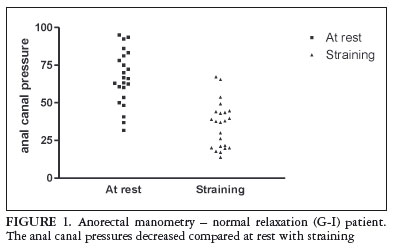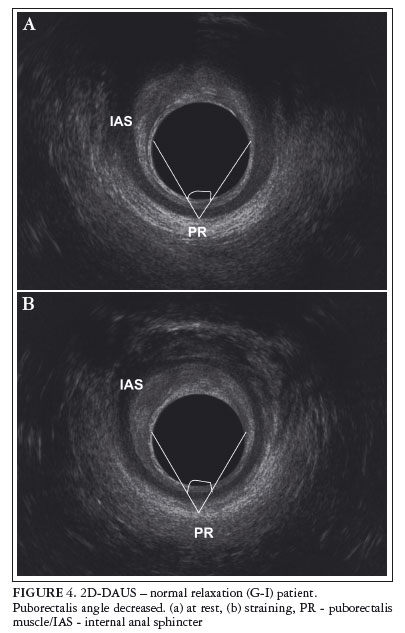CONTEXT: Anismus is a prevalent functional cause of outlet delay. It is characterized by symptoms of obstructed defecation associated with paradoxical contraction of the pelvic floor muscles. OBJECTIVE: To evaluate the ability of two dimensional anal ultrasonography to identify anismus patients with paradoxical contraction or normal relaxation, comparing findings with manometric measurements. METHODS: Forty-nine women presenting with outlet delay and a mean validated Wexner constipation score of 13.5 were included in a prospective study. Following screening with anal manometry, the patients were assigned to one of two groups: G-I -with normal relaxation and G-II -patients with anismus. Dynamic anorectal ultrasonography was used to quantifier the movement of the puborectalis muscle and to measure changes in the angle between two converging lines drawn from the 3 o'clock and the 9 o'clock positions of the endoprobe circumference to the internal border of the puborectalis muscle. The angle decreases during straining in patients with normal relaxation, but increases in patients with anismus. The agreement between the two techniques was verified with the Kappa index. RESULTS: In manometry, during straining the anal canal pressure decreased by 41.3% in G-I and increased by 168.6% in G-II, indicating a diagnosis of anismus for the second group. In US, during straining, the angle produced by the movement of the puborectalis muscle decreased from 63 ± 1.31 to 58 ± 1.509 degrees (P = 0.0135) in 23 of the 30 patients in G-I, indicating normal relaxation, and increased from 66 ± 0.972 to 72 ± 0.897 degrees (P = 0.0001) in 16 of the 19 patients in G-II, indicating anismus. The index of agreement between manometry and two dimensional anal ultrasonography was moderate: 77% (23/30) for G-I and 84% (16/19) for G-II. CONCLUSION: Two-dimensional dynamic anal ultrasonography showed similar results previously suggested by anal manometry at identifying patients with normal relaxation or paradoxical contraction.
Endosonography; Anus diseases; Constipation; Manometry






